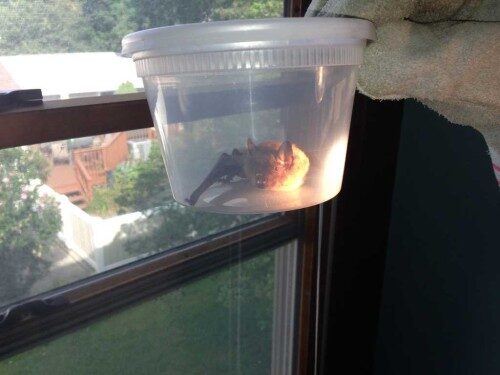
By JOHN T. WARD

The bat was the second to get into the Irving Place residence in a matter of days, said the owner, who asked that his name not be published out of concern for privacy. The first, which was also captured, turned out to be disease-free.
The rabid bat was also the third bat to get into a Red Bank home in less than two weeks, says Animal Control Officer Henry. And one got into the Red Bank Charter School less than two weeks ago, too.
Perez said he can only recall having caught one rabid bat before – several years ago, also on Irving Place.
Despite the possible appearance of a town gone batty, however, the incidence of rabid bats is no higher this year than in past years, said Sandy Van Sant, a health officer with the Monmouth County Regional Health Commission, which serves Red Bank and 20 other towns.
In fact, this year’s numbers are well below those in 2012, when 68 animals statewide tested positive for rabies, far above the usual range of 20 to 40, said Van Sant. The 2012 results are considered a statistical anomaly, she said.
Only three bats tested positive in Monmouth County in the first six months of the year, she said, which is normal. Raccoons and cats are more likely to be carriers of the disease, said Van Sant.
Still, the presence of a bat in one’s home can be unnerving.
The Irving Place homeowner said his wife discovered the first bat flying in a hallway when she got up to use the bathroom in the middle of the night. The bat was captured, and as per public health protocols, was killed for testing. It proved uninfected.
Just a few nights later, another bat got into the house, “and this one was just nasty, making all kinds of noises,” said the homeowner. “He was pretty much barking at you.”
Perez said he found the bat clinging to a door near the floor, which is unusual, because they prefer to be as high as possible when resting, he said.
“I told the homeowners, ‘this bat is not acting right,'” Perez said. “I just knew something was wrong.”
The bat proved rabid. Following federal Centers for Disease Control guidelines on people exposed to bats in enclosed places while sleeping, the couple began a regimen of innoculations that takes two weeks to complete.
The shots are needed, health officials say, because the teeth of a bat are so fine that a human might not feel a bite or scratch, and there might not be any marks left afterward.
“And the problem is, rabies is not treatable,” said Van Sant. “So you have to prevent it.”
On Oakland Street, the Charter School also had a bat visitor late last month, said Principal Meredith Pennotti.
“We think it came in a window that was inadvertently left open on the third floor by some volunteers who were helping with painting,” she said in an email to redbankgreen. “It flew right out when the door was opened.”
There is no evidence of any other bats in the school, said Pennotti.
Perez said that a bat caught indoors should not be released if there is any possibility a human or pet was bitten.





















